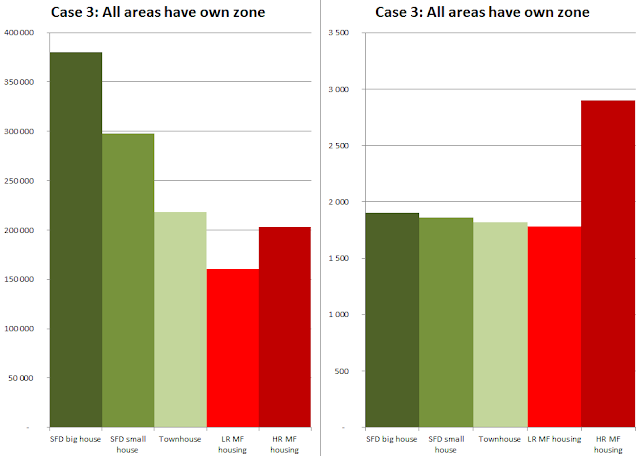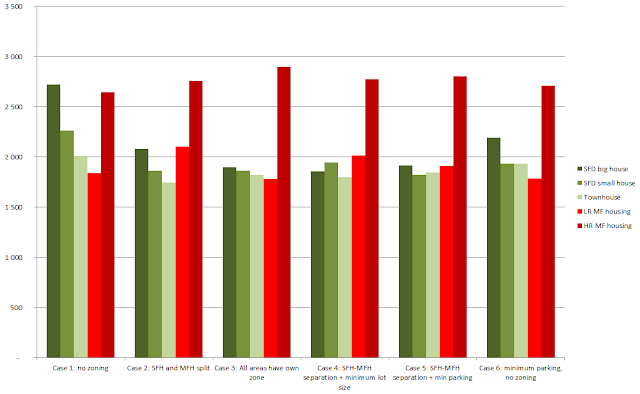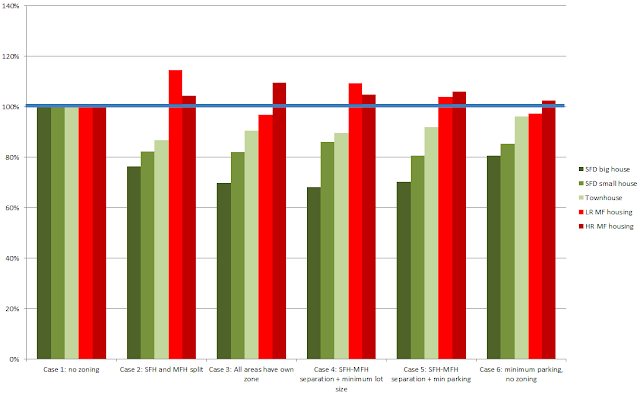How's that for a clickbait title? No, it's not a late April First joke either.
One of the first advice people will read from urbanists is a strong recommendation in favor of mixing uses. It always comes back, however, it is not actually very clearly defined what "mixed use" means, or rather how close must uses be before we consider that they are mixing?
For example, all would agree that the following pattern (green=residential, red=commercial/industrial) is not mixed, as the two uses are grouped together with a buffer (white) between each:
 |
| Clearly not mixed |
On the other hand, the following pattern, all would agree, is mixed:
But what about the two following patterns, are they mixed or not?
It's easy to find the first pattern, just check out any cities in sprawl, with stores and industries gathered around highway interchanges and endless exclusively residential areas beyond that:
 |
| Search for "stores" near Atlanta, the center of the image is all residential (the stores in the area are mainly false positives or home businesses), stores are concentrated at highway interchanges |
However, the second pattern is found next to nowhere. The idea of having stores equally distributed in a city seems to make little to no sense. In some very dense cities, you do have small stores here and there, but most stores still gather in nodes or on certain arterial streets, and offices tend to concentrate in some areas too.
Even in the densest cities, like Barcelona, this tendency for commercial uses to group together is easily seen:
 |
| Barcelona, stores in red, restaurants in green, some nodes and corridors identified |
 |
| French village, typical example of the central node pattern |
So again, what does "mixed use" mean? Clearly, we have plenty of successful cities where uses are separated, in fact, it is hard to find someplace where uses aren't separated to some extent, resulting in active commercial areas and sleepy residential streets, even in the heart of cities.
 |
| St-Laurent Boulevard in Montréal, every building is commercial or office |
 |
| 1 bloc away from St-Laurent boulevard, all buildings are residential |
 |
| A commercial street in Manhattan, again, nearly everything at street level is commercial |
 |
| Mainly residential street in Manhattan |
Mixed use buildings
Some could point out that there are mixed use buildings, especially common in the highest density cities in the world, like Barcelona and Manhattan. The classic mixed use building is quite simply a commercial ground floor with residential apartments or offices on the upper floors, a type of building very common in the world's densest cities.
 |
| Mixed use buildings in Barcelona, store fronts on the ground floor, apartments above |
These can be seen as an evolution of the traditional urban houses of earlier times, where people lived in the same building in which they worked, in the rooms on the 2nd floor or above, while the ground floor was reserved for their economic occupation, whether it be restaurant, a small office or even a small workshop.
But is it really mixed? Yes, there are 2 or more uses per building, but it is not mixed evenly in the buildings, there is a clear pattern. Commercial uses, if present, are always on the ground floor, I've never seen a building with residential units on the ground floor and commercial uses on the upper floors. We could even talk of vertical use separation.
Why do uses separate?
So clearly, these patterns seem pretty universal, whether a city is planned or not, there is a phenomenon wherein uses will tend to separate. Why is that?
I think the main reason is that locations are not necessarily universally desirable for all uses. In fact, desirability for a given location often varies wildly depending on perspective. If we think about it, we might identify a few desired features of each use.
Residential: people typically want their housing to be located near to transport infrastructure and to stores and services, HOWEVER, people also want privacy and quiet for their residence. Which means that highly-trafficked streets are not desired by residential uses as it results in a lot of noise and may affect privacy, especially for the ground floor. Residential uses therefore want some buffer with main arterials, whether that buffer is horizontal (located on a side street for instance) or vertical (once you're high enough, you're no longer as affected by noise nor do your perceive traffic so much). Once upon a time, before elevators, higher units would be undesirable because of the stairs, but with elevators, that's a moot point.
 |
| Residential desirability, per floor, in relation to an arterial (the large black road), red=undesirable, yellow=slightly undesirable, green=desirable |
Commercial: Stores and other commercial offices tend to have a mirror desirability to residential uses. Though both residential and commercial want to be near one another, people choosing their residence flee from traffic and noise, while stores are drawn to them like moths to a flame. Well, noise is not desired but commercial uses are often indifferent to it. Traffic is crucial because the best publicity is being on the way of thousands of people's daily trips. Whether that traffic is pedestrians, cyclists, drivers or, sometimes, transit users, it doesn't matter. The important thing here is VISIBILITY, the opposite of privacy. The more people pass in sight of a store, the higher the potential for pass-by trips. Unlike residential uses, the higher the floor, the less visible it is, so the less desirable the location.
 |
| Commercial desirability, per floor, in relation to an arterial (the large black road), red=undesirable, yellow=slightly undesirable, green=desirable |
Offices: offices are workplaces where plenty of people work. often on fixed schedules. As a result, offices generate a lot of trips in the peak travel periods, but they require little to no freight to operate as they produce services, not goods. Offices don't care much about visibility or privacy in general, though noise may be distracting for employees, they don't have much pass-by clients, and even less pass-by employees! People using their services generally learn of their existence through other means (internet, business contacts, etc...). What offices want most of all is to be located at nodes of regional passenger transport links. That way, they have access to larger pools of potential employees and they don't have to fear lost productivity due to congestion getting to work. So they will tend to mass around transport nodes, public transport or highways.
 |
| Office desirability, per floor, in relation to an arterial (the large black road), red=undesirable, yellow=slightly undesirable, green=desirable |
Like commercial uses, they sometimes have an advantage in congregating together, because sometimes offices require each other's services. Also, in the modern world, with job security on the decline, the concentration of industries in given nodes allows to mitigate the effects of changing jobs. Having your contract not renewed is bad, but if you have half a dozen other potential employers within a 10-minute walking distance, at least you can hope for not having to move your family to accommodate your next job.
Since offices generate quite a bit of traffic, commercial uses may be attracted to them too.
Industries: Industries are a bit like offices, with high peaked traffic, though generally not as high, especially with modern automation. However, unlike offices, industries depend a lot on freight, so instead of desiring locations near nodes of passenger transport links, they want to be near nodes of freight transport links: train station, ports, interstate freeway exits. Most industries rely on just-in-time transport, so unreliable freight, including due to congestion, is highly undesirable for them and they may move out of areas if freight becomes too unreliable. Unlike all the other uses, industries will not particularly favor urban areas, industries take too much space, which is expensive in cities, and they don't benefit from traffic. They still want to be reachable to employees, but they can be satisfied with being out of the way and accessible by shuttles, because transport demand is highly predictable and limited in time.
Note that when freight and passenger transport links overlap, like on highways, this can create tensions between industries and offices who can then go after the same locations, submerge them with congestion, which pushes industries ever further out.
So to sum up, each use favors different locations. So in a completely free development context, we could expect uses to separate over time anyway following a certain logic. Some uses will still favor proximity to one another (residential and commercial uses mostly), but they will tend to maintain some buffer, whether horizontal or vertical, with one another.
So we get to a final definition of "mixed use", a regulatory one. A zone can be called "mixed use" in urban planning if it allows for multiple uses within it without regulatory oversight. This is ideal because it creates a margin of error for planners. With exclusive zoning, planners need to be able to predict exactly how demand for the different uses will evolve. If they do not, then they create artificial land shortages for a type of use and over-supply of land for other uses, which unbalances cities and their local economies. A sadly too typical response in these cases is building new roads to open up new lands to solve the shortage rather than review current zones.
With mixed use zoning, uses can grow inside each other's zones, at least in certain areas zoned for mixed uses. This mitigates the problem of zoning and reduces the need for hyper-competent planning (which is a beast as rare as unicorns).
The most important aspect of "mixed use" is the regulatory one: if zoning is used, zones should allow for multiples uses inside them, to provide margins of error to planners and their inevitable failure to predict correctly evolving demand for the different uses. If regulations don't allow for mixed uses, then it will inevitably create shortages of land for some uses and over-supply for others, creating distortions in the economy and failing to allow communities to grow so as to respond to their own needs.
Note that when freight and passenger transport links overlap, like on highways, this can create tensions between industries and offices who can then go after the same locations, submerge them with congestion, which pushes industries ever further out.
So to sum up, each use favors different locations. So in a completely free development context, we could expect uses to separate over time anyway following a certain logic. Some uses will still favor proximity to one another (residential and commercial uses mostly), but they will tend to maintain some buffer, whether horizontal or vertical, with one another.
So what does it all mean?
What this reasoning would entail is that use separation can be expected to be a spontaneous reaction and is not necessarily bad.So we get to a final definition of "mixed use", a regulatory one. A zone can be called "mixed use" in urban planning if it allows for multiple uses within it without regulatory oversight. This is ideal because it creates a margin of error for planners. With exclusive zoning, planners need to be able to predict exactly how demand for the different uses will evolve. If they do not, then they create artificial land shortages for a type of use and over-supply of land for other uses, which unbalances cities and their local economies. A sadly too typical response in these cases is building new roads to open up new lands to solve the shortage rather than review current zones.
With mixed use zoning, uses can grow inside each other's zones, at least in certain areas zoned for mixed uses. This mitigates the problem of zoning and reduces the need for hyper-competent planning (which is a beast as rare as unicorns).
Conclusion
What is "mixed use"? There is no one correct definition, everyone could debate on how close is close enough before uses are considered to be "mixing". And anyway, left to their own devices, uses are quite likely to separate and congregate on their own, as each use favors different types of location. The important thing should be proximity and scale. You can have a city where uses are separated, as long as these uses are separated based on a human, walking, scale and not on a "highway-driving car" scale, that way, uses can remain in close proximity to one another, when it is beneficial for them.The most important aspect of "mixed use" is the regulatory one: if zoning is used, zones should allow for multiples uses inside them, to provide margins of error to planners and their inevitable failure to predict correctly evolving demand for the different uses. If regulations don't allow for mixed uses, then it will inevitably create shortages of land for some uses and over-supply for others, creating distortions in the economy and failing to allow communities to grow so as to respond to their own needs.

















